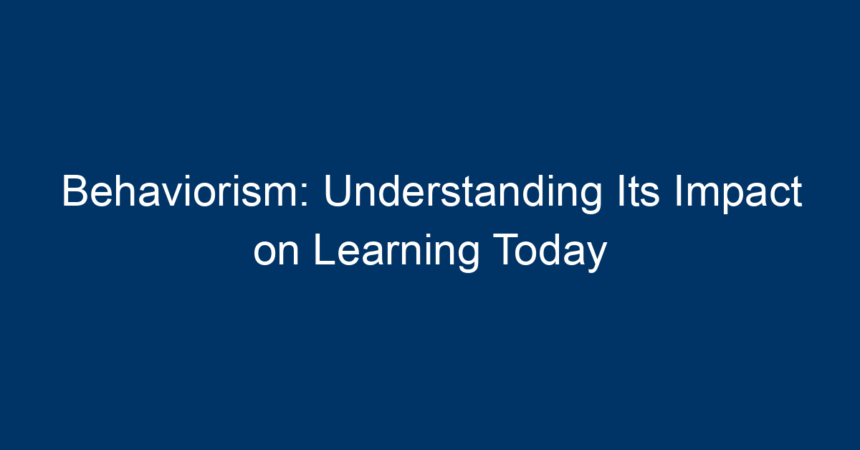Behaviorism is a psychological theory that focuses on observable behaviors rather than internal thoughts or feelings. Founded in the early 20th century, this approach has significantly influenced modern education and learning practices. In this article, we will explore the principles of behaviorism, its impact on learning today, and actionable insights for educators and parents looking to implement behaviorist techniques in their teaching strategies.
What is Behaviorism?
Behaviorism emerged as a reaction to introspective methods in psychology. Pioneers like John B. Watson and B.F. Skinner proposed that all human actions are the result of conditioning through interaction with the environment. They believed that by controlling the variables in a person’s environment, we could predict and modify behavior.
Behaviorism emphasizes:
- Observable Behavior: Instead of exploring unobservable mental states, behaviorism focuses on what can be seen and measured.
- Conditioning: This concept includes both classical conditioning (associating an involuntary response with a stimulus) and operant conditioning (reinforcing desired behaviors through rewards or consequences).
- Environment’s Role: The environment plays a crucial role in shaping behavior, with behaviors viewed as responses to external stimuli.
The Theoretical Framework of Behaviorism
Several theories underpin behaviorism, forming the basis for its applications in learning:
1. Classical Conditioning
Initially demonstrated by Ivan Pavlov through experiments with dogs, classical conditioning involves creating associations between two stimuli. In education, this can manifest through creating positive associations with learning environments, helping students feel more relaxed and focused.
2. Operant Conditioning
Skinner expanded on Pavlov’s work, introducing operant conditioning, which focuses on how behaviors can be modified through reinforcement. This can be positive (rewards for good behavior) or negative (removal of an unpleasant stimulus). Educators often utilize operant conditioning techniques through systems of rewards and punishments to shape student behavior.
3. Reinforcement Schedules
The timing and frequency of reinforcement can significantly influence behavior. Schedules can be fixed or variable, continuous or intermittent. Understanding these patterns helps educators strategize effective reward systems.
The Impact of Behaviorism on Learning Today
Behaviorism has left an indelible mark on contemporary educational practices. Here are some key areas where its influence is evident:
1. Structured Learning Environments
Many classrooms today are structured to reinforce desired behaviors. Well-defined rules, routines, and procedures create a predictable environment where students know what is expected of them. Such structured settings help reduce anxiety and allow students to focus on learning.
2. Use of Technology in Education
Technology has become an integral part of learning, often used in ways that align with behaviorist principles. Educational software and apps frequently employ gamification, where students are rewarded with points, badges, or levels for completing tasks. This system not only motivates students but also means that their progress is easily measurable.
3. Behavior Modification Techniques
Behavior modification is a key application of behaviorism in educational settings. Techniques include:
- Token Economies: Students earn tokens for desirable behaviors, which they can exchange for rewards.
- Contingency Contracts: Agreements between teachers and students that outline expected behaviors and the consequences of meeting or failing to meet these expectations.
- Self-Monitoring: Encouraging students to track their own behavior and learning progress, fostering a sense of responsibility.
4. Focus on Mastery Learning
Mastery learning, influenced by behaviorist principles, emphasizes that all students can learn if they are provided with the right resources and enough time. This approach often involves breaking down content into smaller, manageable units and ensuring that students achieve mastery before moving on to more complex topics.
Critiques of Behaviorism
Despite its significant contributions to educational psychology, behaviorism has faced criticism, particularly regarding its limitations:
1. Neglect of Internal Processes
Critics argue that behaviorism overlooks the complexities of human cognition and emotion. Students are not just passive recipients of information; they also engage in critical thinking and self-reflection. This neglect of internal cognitive processes can lead to a shallow understanding of material.
2. Overemphasis on Reinforcement
Solely relying on external rewards may lead students to seek out only the immediate gratification that comes with rewards, rather than developing intrinsic motivation for learning. This can hinder long-term engagement and interest in academic subjects.
Blending Behaviorism with Other Educational Theories
To address its limitations, many educators today are integrating behaviorism with other learning theories. For instance:
1. Constructivism
Constructivist approaches emphasize that learners construct their own understanding and knowledge of the world through experiencing things and reflecting on those experiences. By combining behaviorist techniques with constructivist methods, educators can create a more holistic learning environment that fosters both observable behaviors and cognitive development.
2. Social Learning Theory
Albert Bandura’s social learning theory posits that people learn from one another via observation, imitation, and modeling. Incorporating elements of social learning with behaviorist principles can enhance cooperative learning strategies and peer interactions in the classroom.
Actionable Insights for Educators and Parents
Embracing behaviorism doesn’t mean you neglect to address the cognitive and emotional aspects of learning. Here are some actionable strategies to maximize the benefits of behaviorism in educational settings:
1. Implement Clear Expectations
Establish clear and specific expectations for behavior and academic performance. Use visual aids and reminders to help reinforce these standards.
2. Utilize Positive Reinforcement
Employ a variety of positive reinforcement strategies to encourage desirable behaviors. Tailor your approaches based on individual student needs and preferences.
3. Incorporate Technology Mindfully
Use educational technologies that employ gamification and other behaviorist strategies to engage students. Monitor and assess their effectiveness continuously to ensure they meet educational goals.
4. Track Progress
Implement regular assessments to track student progress. This can help identify areas for improvement and provide timely feedback to students.
5. Foster a Growth Mindset
Encourage a growth mindset by teaching students that ability is cultivated through effort and perseverance. Balance behaviorist techniques with strategies that promote intrinsic motivation and resilience.
Conclusion
Behaviorism has profoundly influenced how we approach learning in today’s educational landscape. By understanding its principles and impact, educators and parents can better navigate the complexities of teaching and learning. Applying behaviorist techniques alongside other learning theories can create a rich, engaging, and effective educational experience. Embracing a blended approach enables us to cater to different learning styles and supports the holistic development of every student.
As we move forward, let us remember that while behaviorism provides valuable insights into behavior and learning, it is just one piece of the intricate puzzle that is education. By fostering environments that promote both behavioral and cognitive development, we can nurture learners who are not only knowledgeable but also motivated, resilient, and adaptable.




